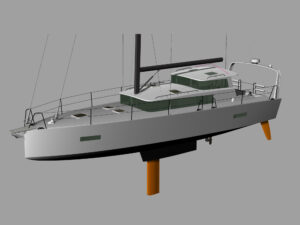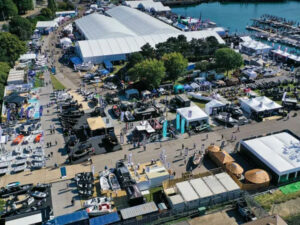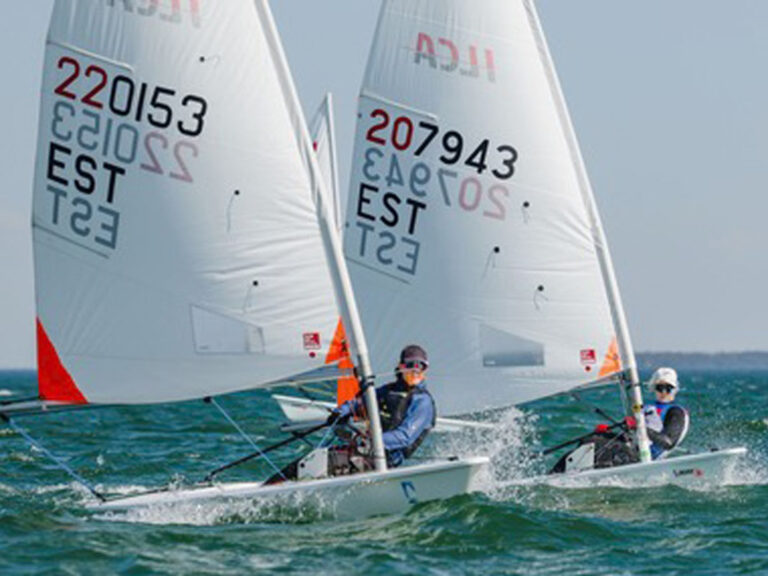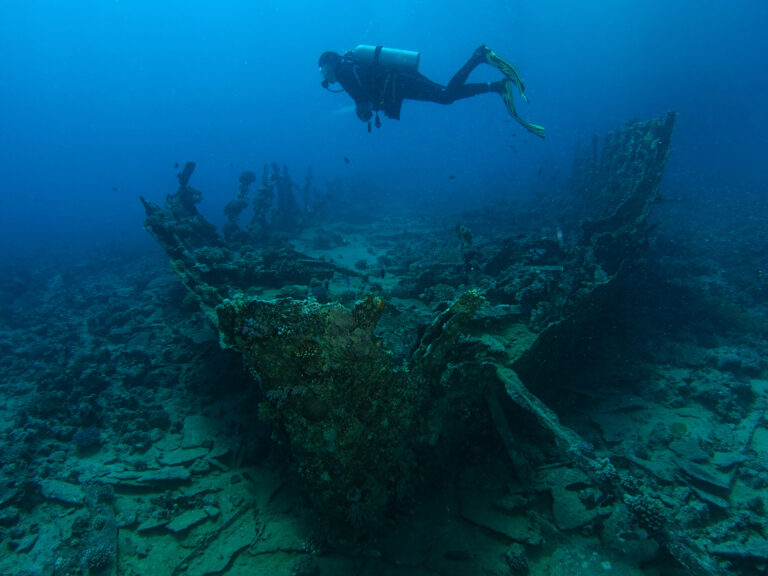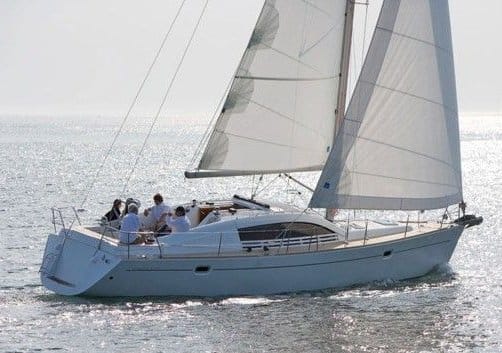
The Pilot Saloon 41 is Wau-quiez International’s latest raised-deck-saloon offering in a series that began in 1991 with the Wauquiez 60 and continued most recently with the Pilot Saloon 47.
The object of the pilot-saloon concept is to avoid the cavelike feeling of traditional boat interiors by providing a panoramic view of the horizon, not just of the sky, for anyone in the saloon, nav station, or galley. Both the 47 and the 41 have essentially the same basic layout, with a master stateroom aft and a private head, another stateroom forward, also with its own head, and the galley/saloon/nav station amidships.
Smaller boats present their designers with greater aesthetic challenges because the most difficult dimension to deal with, height, is fixed by the headroom requirement. Raising the coachroof to provide the view only compounds the difficulty. To its credit, Berret Racoupeau has controlled the proportions of the Pilot Saloon 41 while retaining most of the features, both visual and physical, of the 47, which it closely resembles in profile.
Some of those visual features are accomplished by the use of secondary moldings that allow shapes not possible in a one-piece deck. These moldings also provide covers to conceal and, to some extent, protect sail-control lines that lead to the cockpit. The result is a superstructure that, though high, draws the eye forward and aft, away from the coachroof.
Such styling both gives and takes away. The saloon roof is high, and climbing onto it to furl the mainsail is awkward, but once there, you’re working from a position of authority, well above the boom. That same high roof provides a base for waist-high grabrails, a boon when going forward or when stepping aboard through the lifeline gate. As the roofline dips aft, it continues as the cockpit coaming, creating a sheltered area forward, with deep seat backs. The coaming also wraps around the stern, providing good seating behind the helm.
The steering console is large enough to accommodate modestly sized display units, but it doesn’t dominate the area, and the table folds against the console to clear the cockpit when sailing. A centerline footbrace would help shorter crewmembers stay on the windward seat, but it would need to be removable so it wouldn’t stub toes while in port. A couple of design elements piqued my curiosity. The bulkhead at the aft end of the cabin trunk slopes to gain headroom below, but to me, its angle seems a little too pronounced to be comfortable as a backrest. Because of the way the coaming widens inboard to form the helm seat, when the boat heels, water will puddle in the leeward cockpit seat. A small modification to the deck mold would fix this.
Because the cockpit is elevated along with the saloon roof, the view from the helm is unimpaired. The bridge-deck makes an ideal perch, sheltered under the dodger and framed by the cabin extensions, from which to observe the world in comfort, which will endear the 41 to the night watch. Just below, to port, is the nav desk and a handy shelf with deep fiddles that will hold a flashlight, binoculars, or other accessories. A wet locker is strategically placed alongside the companionway.
A raised-saloon configuration requires a little fancy footwork-not just on the part of its designers but also from those who use it. The cabin sole is, out of necessity, on several levels.
On the 41, the companionway ladder leads down to the dining area and the nav desk. A step down to the galley brings the cook, working on the port side, eye-level with the diners, seated to starboard. Down a step aft is the master cabin. The forward stateroom is down another step from the galley. Wauquiez has worked with this arrangement long enough to have made the transitions intuitive, and the payoff in visibility is dramatic.
To provide that view, the saloon seating has to be brought inboard. This makes the saloon narrower than on a comparable boat of conventional layout, but the size reduction provides lots of support for moving safely about below when the sea action is lively. The vacated space under the starboard-side deck provides valuable stowage. The seating itself is a rectangular U shape, which offers several ways to stretch out comfortably. Let’s toast the designers for eschewing the circular-seating template.
The staterooms benefit immensely from the boat’s high freeboard. If the forward berth gets a little tight at the pointy end, the aft cabin provides a great deal more space and walkabout room than in most aft-cockpit layouts. Belowdecks, the saloon settee is fitted with a lee cloth, and the master berth has a split mattress and lee cloths to separate and secure a pair of sleepers. The layout is for the most part conducive to safe and easy movement, with the possible exception of the space between the companionway and the nav desk, which might prove awkward when descending the ladder on starboard tack.
Big saloon windows on any sailboat draw attention, not just because they provide lots of light but also because they can be vulnerable in big wind and seas. Those on the Pilot Saloon 41 are made of an acrylic material thick enough to be structural and bonded to the cabin trunk with a specialized adhesive. Wauquiez has made the most of its windows with opening ports set along their lower edges and disguised (and sheltered from rain) by louvered trim pieces on the outside.
Wauquiez offers several sail options: furling or conventional main, genoa or self-tacking jib, and a furling reacher. Since this boat can easily gain weight with the addition of a generator and other goodies, a full-battened main and genoa, plus a code-something for off the wind, might be the right combination for light-air waters.
So how does the boat perform? Our brief window of sailing opportunity gave us less than 5 knots of wind and inconclusive results. During the motoring test, though, we measured boat speeds of 8.5 knots at 3,100 rpm and 7.4 knots at a gentle 2,300 rpm. The conventional propeller induced a little walk when backing up from a dead stop, but the rudder quickly overcame it once the boat gained way.
Wauquiez promotes the Pilot Saloon 41 as a liveaboard cruising boat that’s fully ocean capable, and several standard features support that goal: a jackline kit, padeyes installed to receive them, and padeyes for harnesses in the cockpit. Granny bars around the mast would tighten up that area and complement the cabin-top handrails.
Forward, the windlass is tucked under a hatch that reveals a storage bin. Twin rollers show the builder is serious about anchoring, but a silly design glitch means that a wrap of 5/8-inch line around the starboard mooring cleat effectively traps the hatch shut.
Storage and “technical” spaces abound, especially in the midship area, including the bilges, where a real sump allows the bilge pump to keep them dry. The engine, under the foot of the companionway, is easy to reach and service, and so, comfortingly, is the stern gland.
The Wauquiez trademark stern platform hinges out of the transom and has no ladder for swimmers. A light chop would make it dangerous to board from a dinghy, and it would be a liability should the life raft, tucked into a dedicated recess behind it, be needed. In almost all other respects, the Wauquiez Pilot Saloon 41 will prove to be a safe, comfortable boat, not just at the cruising grounds but on the way to them. It’s well thought out, well executed, and well-appointed throughout.
Wauquiez Pilot Saloon 41 Specs
LOA (hull): 41′ 0″ (12.50 m.)
LWL: 36′ 1″ (11.00 m.)
Beam: 13′ 3″ (4.04 m.)
Draft (standard): 5′ 9″ (1.80 m.)
Sail Area (100%): 687 sq. ft. (63.8 sq. m.)
Displacement: 22,050 lb. (10,000 kg.)
Water: 116 gal. (440 l.)
Fuel: 58 gal. (220 l.)
Engine: 54-hp. Yanmar
Designer: Berret Racoupeau
Price: $302,535
Wauquiez International, (410) 267-8181, www.wauquiez.com
Jeremy McGeary is a Cruising World contributing editor.



